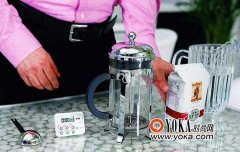The meaning and Origin of Cappuccino
A brief introduction to cappuccino
Cappuccino is an Italian coffee mixed with the same amount of Italian espresso and steamed milk. Its color is like a cappuccino monk covering a dark brown coat with a headscarf, hence the name cappuccino.
Cappuccino has an irresistible unique charm, at first it smells delicious, the first sip, you can feel a lot of milk foam sweet and soft, the second mouthful can really taste the original bitterness and richness of coffee beans, finally, when the taste stays in the mouth, you will feel more mellow and meaningful …... Don't you think it's amazing that a kind of coffee can have many different unique flavors? The first mouthful always makes people feel bitter and sour, a large number of bubbles are like young people's light life, and the bursting of bubbles and that little bitterness are like a conflict between dreams and reality. Finally, after tasting the joys and sorrows of life, the sweetness of life is intoxicating. This is like a teenager in adolescence. After enjoying a childish and wonderful time, they have to face the impact of stepping into the adult world and really taste the original taste of life-in addition to sweetness and bitterness.
The origin of cappuccino
Cappuccino has a very learned origin and has always been the best material for the study of character changes in Europe and the United States.
The Origin of Cappuccino
The history of the word Cappuccino: the monks of the St. Franciscan Church (Capuchin), founded five years later in 1525, all wore brown robes and pointed hats. When the St. Franciscan Church spread to Italy, the locals thought the monks' clothes were very special, so they gave them the name Cappuccino. The Italian word refers to the loose robes and small pointed hats worn by monks, derived from the Italian word "headscarf" or Cappuccio.
However, Old Yi loved coffee and found that when espresso, milk and milk foam were mixed, the color was like the dark brown robe worn by monks, so he came up with a drink with coffee and sharp milk bubbles, which was named Cappuccino. The word was first used in English in 1948, when a report in San Francisco first introduced cappuccino beverages, and it was not until 1990 that it became a familiar coffee drink.
It should be possible to say that the word Cappuccino coffee comes from the St. Franciscan Church (Capuchin) and the Italian headscarf (Cappucio). It is believed that the original word makers of Cappuccino never dreamed that the monks' robes would eventually become the name of a coffee drink.
Cappuccino is also associated with a monkey name: there is a small monkey in Africa with a black cone-shaped hair on its head, much like a pointed hat on a St. Franciscan robe, hence the name Capuchin, which was first used by the British in 1785. The word Capuchin has generated coffee drink names and monkey names hundreds of years later, which has always been an interesting story for literati.
Important Notice :
前街咖啡 FrontStreet Coffee has moved to new addredd:
FrontStreet Coffee Address: 315,Donghua East Road,GuangZhou
Tel:020 38364473
- Prev

The origin and history of mocha coffee
Mocha coffee is produced in Ethiopia. Beans are small and fragrant, with strong sour and mellow taste, moderate sweetness and special flavor.
- Next

Usage Press pot DIY Delicious coffee
Just as the pleasure of making the next delicious meal may outweigh the taste, making a cup of coffee for yourself and for a loved one can be an enjoyable process. Are you ready? It only takes a few minutes for your delicious coffee to taste. Starbucks coffee experts personally demonstrate, teach you to make coffee by hand. Tip
Related
- How did the Salvadoran coffee industry develop in Central America?
- What exactly does the golden cup extraction of coffee mean?
- The Origin of Coffee flower
- [2023 Starbucks World Earth Day] there are more meaningful things besides free Starbucks coffee!
- What kind of coffee is there in Spain? 9 Flavors of Spanish Coffee
- Aromatic African coffee| Kenya's coffee culture and historical production area
- Liberica Coffee Bean knowledge: the characteristics of Liberian Coffee beans of the three original species of Coffee beans
- The origin and formula of Spanish latte introduces the taste characteristics of Bombon coffee in Valencia, Spain.
- How to adjust the solution of over-extracted coffee
- What is the tasting period of coffee beans? What is the period of coffee and beans? How should coffee wake up and raise beans?

